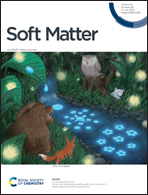Spatiotemporal control of calcium carbonate nucleation using mechanical deformations of elastic surfaces†
Abstract
Biological systems generate crystalline materials with properties and morphologies that cannot be duplicated using synthetic procedures. Developing strategies that mimic the control mechanisms found in nature would enhance the range of functional materials available for numerous technological applications. Herein, a biomimetic approach based on the mechano-dynamic chemistry of silicone surfaces was used to control the rate of heterogeneous CaCO3 nucleation. Specifically, stretching the silicone surface redistributed functional groups, tuning interfacial energy and thus the rate of CaCO3 crystal formation, as predicted by classical nucleation rate laws. We extended this procedure using microrelief patterns to program surface strain fields to spatially control the location of nucleation. The strategies presented herein represent a fundamental departure from traditional bottom-up crystal engineering, where surfaces are chemically static, to them being active participants in the nucleation process controlling the outcome both spatially and temporally.



 Please wait while we load your content...
Please wait while we load your content...
